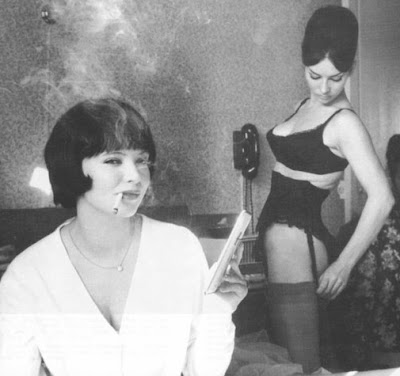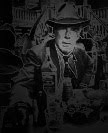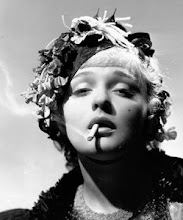
Godard’s Alphaville as Ed-Woodsian Drive-in Sci-Fi Schlock
Jean-Luc Godard’s 1965 film ALPHAVILLE is about a futuristic private eye who arrives from outer space in a Ford Mustang, which he calls a “Jet Galaxy,” and lands in a strange city where all the people are controlled by a weird professor and his giant computer. The intergalactic detective’s name is Lemmy Caution, Secret Agent Zero Zero Three, but he calls himself “Ivan Johnson.” The spooky professor’s name is Leonard Nosferatu, but he calls himself “Von Braun.” He has two assistants named “Heckell” and “Jeckell.” The huge electronic brain is named Alpha-60. The chain-smoking space detective wears a trenchcoat and a .45 as he explores the strange dark city, meeting his secret contact and planning an assassination. Agent Caution soon learns that the citizens of Alphaville are dominated by the perfect logic of Alpha-60 and have lost their ability to think independently or feel emotions. Those who even try to think independently are made to walk out on a diving board, where they are machine-gunned into a swimming pool filled with knife-wielding mermaids. The alien spy falls in love with a programmed human Seductress named Natascha, who just so happens to be Professor Von Braun’s daughter. After pages and pages of incomprehensible dialogue, the private eye is captured by the monster computer and made to answer strange questions like, “What is the privilege of the dead?” Lemmy Caution makes his escape by blowing up Alpha-60 and driving off with Natascha in his Ford Mustang. Ed Wood, Jr. would have been proud.

French “New Wave” auteur Jean-Luc Godard worked in the construction and printing trades, dabbled in film criticism, and eventually made friends with several guys, like Francois Truffaut, Jacques Rivette, and Eric Rohmer, who wanted to make movies. Godard loved John Ford westerns, like TWO RODE TOGETHER and THE SEARCHERS, but Godard himself made very slow, very talky movies with neurotic characters who droned on and on in long, slow monologues. He turned his camera on and left it on until it was time for a jump cut, at which point he filmed something else completely different, like a billboard, a flashing sign, or a steer being butchered. His characters were frequently out-of-frame, but Jean-Luc didn’t seem to mind. His characters talked to themselves about the weather, as if they had even bored themselves, but Godard didn’t care. He told everyone that it was a new kind of cinema. It was about Truth with a capital “T.” It was about people NOT communicating. His “Nouvelle Vague” film technique was about revolution and cinema verite and contempt for the rules of filmmaking. He became a darling of the film critics. He was an Artist with a capital “A.” He married a very pretty girl named Anna Karina and put her in a few of his films. He divorced her, married another girl named Anne Wiazemsky, and put her in some more films. (Godard apparently has an “Anne” fetish, for his third wife’s name was Anne Marie Miéville.) He issued proclamations like, “I make film to make time pass.” He said, “Tracking shots are a question of morality” and “You can’t kiss a movie.” He was so Deep, nobody cared if he made sense. He was so cool, he put Brigitte Bardot in a movie (CONTEMPT, 1964) and had her read the credits out loud on screen. The motto of the Nouvelle Vague was, “Everyone can be a movie director.” During the 1960s, the French intelligentsia was deconstructing Jerry Lewis comedies, while the America and British intelligentsia were deconstructing Godard’s jump cuts.

Like Godard, Edward D. Wood, Jr. loved westerns. He did not dabble in film criticism, but frequently wore fuzzy sweaters. He became a decorated United States Marine in World War II. His friends were not intellectual filmmakers, but drag queens and guys with keys to stock footage rooms, where Ed found whole scenes to pad his movies. Like Godard, Wood wrote lengthly monologues full of non-sequitors and silliness. Unlike Godard, his characters were always in the frame, but so were his microphones. Ed Wood’s cinema was about Money with a capital “M,” namely that he never seemed to have enough money, and it showed in his films. Unlike Godard, Ed Wood was not an Artist with a capital “A,” nor did he become the darling of the critics. Like Godard, Wood put his girlfriend in the movies. Ed Wood had his GLEN OR GLENDA, and Godard had his MASCULINE-FEMININE. Godard had his ONE AMERICAN MOVIE, and Wood had his ONE MILLION AC/DC. Both men filmed women performing lengthly monologues in their underwear. When a scene required a spaceship, Ed Wood got himself some hubcaps on strings, and Godard got himself a Ford Mustang. In BRIDE OF THE MONSTER, Wood used a photographic enlarger to represent a death ray; in ALPHAVILLE, Godard used boom microphones to represent Alpha-60’s sensory arms. When a scene required a futuristic room, Ed Wood painted the plywood set walls silver-gray, and Godard filmed the lobbies of office buildings in Paris. In 1957, Ed Wood was supposed to direct a film called THE DEAD NEVER DIE from a screenplay by Paul Marco and the psychic Criswell, which was to feature several of the actors from PLAN 9 FROM OUTER SPACE; in ALPHAVILLE, the monster computer asks Lemmy Caution, "What is the privilege of the dead?" to which Caution answers, "Never to die." Godard ranted about communism and the inability of people to communicate, while Wood ranted about morality and man’s inability to cross-dress. Wood usually shot his scenes in one take, because he was so short of money; Godard usually shot his scenes in one take, because the scenes he shot were “perfect.” Godard improvised constantly, making the dialogue in his films seem aimless and vague; Ed Wood wrote pages and pages of unintentionally aimless and vague dialogue. Both of them used off-screen monologues, Godard because he felt he had so much to say, and Wood because he couldn’t always afford synchronized sound.

So, with the black and white film ALPHAVILLE, one has a cheap sci-fi movie with nonsensical dialogue, girls in brassieres, cheesy off-screen special effects, and no “redeeming social value” at all. One might think of it as BRIDE OF THE MONSTER without the rubber octopus or PLAN 9 FROM OUTER SPACE in French. Either way, ALPHAVILLE was doing intentionally in 1965 what Ed Wood had been doing ten years before through accident, proverty, and incompetence. In one scene, the monstrous computer Alpha-60 says, “Is it not obvious that someone in the ordinary course of life, living on one edge of pain, should demand a different kind of religion from that demanded by someone who in the ordinary course of life lives on the other edge?” One can almost see Ed Wood with a bellyful of vodka gimlets banging out a line like that on a battered Smith-Corona typewriter in his unfurnished Hollywood apartment. By the time Godard’s ALPHAVILLE came out in 1965, Ed Wood had already moved on to writing such chef d'oeuvres as ORGY OF THE DEAD and SHOTGUN WEDDING.
We can thus enjoy ALPHAVILLE as a weird teenage drive-in attempt at cheesy sci-fi. We can disregard any earth-shaking “messages” that Godard intended to convey or any philosophical analysis. We can forego contemplating Godard’s role in shaping the future of the film narrative. Jean-Luc Godard, in one of his more messianic moods, once said that, “Film is truth at 24 frames-per-second.” It isn’t, of course, and both John Ford and Ed Wood knew it wasn’t. In a different mood, Godard once said, “One never does exactly what one intended.” His ALPHAVILLE was immeasurably profound to the film critics, but is still silly enough and muddled enough to warrant our attention. How can we ignore a movie about a chain-smoking guy with a trenchcoat and a gun, who comes from outer space, blows up a computer and a whole civilization, and then escapes with the girl in a 1965 Ford Mustang? Why think dialectics of cinema when you can think drive-in movie?
_____































No comments:
Post a Comment